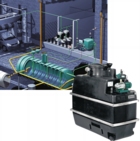Water, water — where you want it

Harvested rainwater is perfectly adequate for uses such as flushing toilets and washing cars.
Representing the integrated approach to rainwater harvesting available from various suppliers is this unit from Wilo.
Short-circuiting the water-supply cycle by harvesting rainwater is an effective way to relieve demand on the mains supply, as John Laming explains.Behind energy saving and reducing emissions, reducing water usage is the hottest topic around at the moment. With water shortages reported recently in Australia, in many Mediterranean countries and in a string of other countries across the globe we are increasingly becoming aware of the fragility of this planet’s future and our place within it. We have huge quantities of water on the ‘blue planet’, but only 2% of it fresh water. We have a growing population, set to hit 9 billion by 2042 (2.7 billion more than now). Not unreasonably, they will all want drinking water, bathing water, better food and a better quality of life — all of which demand more high-quality water. Finding sources of useable water is becoming the train hurtling towards us that carries the light at the end of the tunnel! The excellent ‘American’ answer to all potentially catastrophic situations is to place heavy reliance on currently non-existent new technology emerging from somewhere in time to be the white knight that saves us from the horrors of the moment. It falls to a number of companies to adopt a sensible approach and invest in researching the technology and the practical solutions that can help us to address these challenges. One result is rainwater harvesting — a technology that is far further ahead in development and consumer acceptance in mainland Europe than in the UK. However, it is a rather obvious solution for those parts of the planet that, like our green and pleasant land, seem to get more than their fair share of precipitation, although its no great shock that Norfolk and Suffolk, the driest parts of the UK, are looking at rainwater harvesting more seriously than most of the rest of the country. Wilo brings to rainwater harvesting an established understanding of the problem, combined with a response that offers a number of pre-developed solutions that can slot happily into the rainwater harvesting needs of UK contractors, developers and homeowners. First, let us ask the fundamental question — why do we want to ‘harvest’ rainwater? The answer is simple. Because rainwater is free and with the changing weather patterns we are experiencing often arrives in huge quantities. Unless we harvest this rainwater, it floods us out of our homes and then disappears into streams and rivers and then heads for the sea. Whilst rainwater comes from the sky, you never know when or how much will fall — so we currently collectively participate in a major waste of expensive, cleaned water. For years in the UK we have happily cleaned the water supply before flushing it down the toilet. Do we need to use potable water to flush our toilets, wash our cars and water our gardens? Clearly the answer is no. Water that falls from the sky is, in the main, clean and excellent for tasks that do not involve drinking, cooking and personal hygiene. It would make huge sense for all homes and businesses to have two sources of water — one for drinking, cooking and personal hygiene and the other for flushing toilets and washing cars and, arguably, our clothes. That might happen in time but probably not without legislation In the meantime, many people are beginning to look at voluntarily harvesting the rainwater that falls on their roofs it then makes its way through a mesh filter into a holding tank, usually underground, before being pumped it from that tank to be used in a number of non-potable applications. This can clearly reduce the demand on the mains water supply and can reduce water costs — particularly for a metered water supply. It is essential to have the facility of ‘topping up’ water needs from the mains should the supply in your harvesting tank fall short. Rainwater harvesting systems are far less obtrusive and can be significantly cheaper to install if they are planned into a building, domestic or commercial, at the outset. Retrofitting a rainwater harvesting system is perfectly possible but planning it into the original building makes a huge amount of sense. Whilst in the UK many people thinking of rainwater harvesting will go down the usual ‘British’ road of looking for all the elements they need to install one, developers of rainwater harvesting systems offer advice to ensure you have a working package — including pumps, tank, filters and all the ancillaries, including the clever electronics. There is also help to understand the legislation and regulations involved. The technology and the systems exist; it is just a case of specifying the right system for each job. We recommend harvesting rainwater only from roof areas and not from other surfaces, such as roads. The roof area and its collecting ability should be compared with the number of people in the building. A tall, narrow office block with a relatively small roof area and huge numbers of people working in it may not be ideally suited for rainwater harvesting. Typically in offices, 60 to 65% of all water usage is to flush toilets and urinals. Rainwater harvesting might be ideal for a factory with a large roof area relative to the number of employees or a new home with a large roof area relative to the number of people living in the property. Every building is different and each case must be considered carefully to see if it is a viable option.
John Laming is Wilo UK’s rainwater harvesting manager.
Related links:
Related articles:








